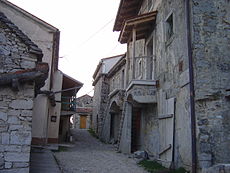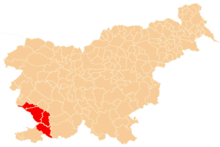- Kras
-
This article is about the region in Slovenia and Italy. For the stadium, see Kras Stadion. For the company, see Kraš. For the oncogene, see KRAS. For the wine, see Carso DOC.
 The cliffs of Duino (Devin) and the gulf of Sistiana, Province of Trieste, Italy, seen from the Rilke trail.
The cliffs of Duino (Devin) and the gulf of Sistiana, Province of Trieste, Italy, seen from the Rilke trail.
Karst (Italian: Carso; German: Karst; Slovene: Kras); also known as the Karst Plateau, is a limestone borderline plateau region extending in southwestern Slovenia and northeastern Italy. It lies between the Vipava Valley, the low hills surrounding the valley, the westernmost part of the Brkini Hills, northern Istria, and the Gulf of Trieste. The western edge of the plateau also marks the traditional ethnic border between Italians and Slovenes.
The region is famous for having given the name to karst topography. For this reason, it is also referred to as the Classical Karst.
Contents
Geographical position
The plateau rises quite steeply above the neighboring landscape, except for its northeastern side, where the steepness is less pronounced. The plateau gradually descends from the southeast to the southwest. On average it lies 334 m above sea level. Its western edge, known as the Karst Rim (Slovene: Kraški rob), is a continuation of the Učka mountain range in eastern Istria, and rises to the east and southeast of Trieste, ending in steep cliffs between Aurisina and Duino. Many interesting geological phenomena occur along the Karst Rim, including the picturesque Rosandra Valley (also known as Glinščica).
Because the Karst steeply descends towards the Adriatic Sea, it is less exposed to the beneficial climatological effects of the Mediterranean. In the past, the main vegetation on the plateau was oaks, but these were replaced by pine forests in the 19th and 20th centuries. Forests now cover only one-third of the Karst. Starting the Middle Ages, the plateau suffered radical deforestation for economic reasons. Although much of the wood for the closely spaced piles that support the island city of Venice, Italy came from this region, Venice carefully managed the Karst forests as a reserve for naval timber. The most radical deforestation occurred in the mid-nineteenth century due to clear-cutting by local farmers and conversion of the land into pastures for sheep.
The Karst is famous for its caves. In Slovenia, they include Vilenica Cave (the oldest show cave in Europe), Lipica Cave, Divača Cave, Kačna Cave, Postojna Cave, and Škocjan Caves (a UNESCO World Heritage Site), and Grotta Gigante in Italy (the largest show cave in the world).
Most of the Karst is located in the Slovenian Littoral, covering an area of 429 square kilometres, with a population of about 19,000 people. The Karst as a whole has exactly 100 settlements. The town of Sežana is the center of the region on the Slovene side of the border. The main rural centers are the settlements of Divača, Dutovlje, and Komen. Štanjel is a picturesque clustered settlement at the top of the northern rim of the plateau; its houses are tightly clustered around Turn Hill, giving it the appearance of a medieval town. On the Italian side of the border, important settlements include Opicina, Duino, and Aurisina.
Natural conditions, including the bora (Slovene: burja) wind, and the local way of life all shaped the elements of Karst architecture, creating simple but well-defined forms. The Karst is renowned for its strong red wine, known as teran, and prosciutto. One of the main tourist centers in the area is Lipica, with its stud farm (the home of the Lipizzan horse breed) as well as other tourist facilities.
Prominent natives and residents
 Karst peasants in a engraving from Janez Vajkard Valvasor's monograph The Glory of the Duchy of Carniola, 17th century.
Karst peasants in a engraving from Janez Vajkard Valvasor's monograph The Glory of the Duchy of Carniola, 17th century.
Prominent persons that were born or lived in this region include the poets Srečko Kosovel, Igo Gruden, Ciril Zlobec and Branka Jurca, social activist Danilo Dolci, architect Max Fabiani, painters Avgust Černigoj and Lojze Spacal, writers Alojz Rebula, Igor Torkar, and Bogomir Magajna, theologian Anton Mahnič, politicians Drago Marušič, Josip Ferfolja and Majda Širca, economist Milko Brezigar, and actress Ita Rina. The picturesque Karst landscape inspired numerous artist that were not from this region, including the poets Rainer Maria Rilke, Alojz Gradnik, and Edvard Kocbek, essayists Scipio Slataper and Marjan Rožanc, writers Italo Svevo, Fulvio Tomizza and Susanna Tamaro, and film director Jan Cvitkovič. Many artists and authors settled in the area, including Josip Osti and Taras Kermauner.
Geographical extension
The municipalities that are completely or partially in the Karst include:
- Italy
- Savogna d'Isonzo (partially)
- Doberdò del Lago
- Sagrado (partially)
- Monfalcone (partially)
- Duino-Aurisina
- Sgonico
- Monrupino
- Trieste (partially)
- San Dorligo della Valle (partially)
- Slovenia
- Miren-Kostanjevica (partially)
- Komen
- Sežana
- Divača
- Hrpelje-Kozina (partially)
Sometimes, the region around Pivka and Postojna is also included.
-
Landscape near Duino
-
The cliffs of Duino
-
Karst landscape in the Province of Trieste
-
The fortified church in Monrupino
-
The village of Lokev near Sežana
-
Karst landscape near Doberdò del Lago
See also
External links
- Karst in Slovenia. Slovenia: a geographical overview. Nadja Zupan Hajna
- PR Office of the Slovenian Government - Kras and Karst
- The Kras and Brkini Region
Sources
- Rosanna Bubola, Vivere il Carso edito dalla Pro Loco di Trieste (Basadello di Campoformico (Udine): La tipografica, 2006)
- Massimo Gobessi& Sergio Dolce, Il Carso in tasca (Trieste: Edizioni Luglio, 2006)
- Elio Forznarič et al., Kras je krasen: vodnik po občinah Kraške gorske skupnosti (Trieste: Kraška gorska skupnost/ Comunità montana del Carso, 1991)
- Daniel Jarc, Il patrimonio culturale del Carso goriziano/ Kulturna dediščina goriškega Krasa (Trieste: SLORI, 1997)
- Miran Lapanje, Sežanski Kras (Sežana: Jamarsko društvo, 1984)
- Mojca Osvald et al., Kras in slovenska Istra (Ljubljana: Gimnazija Bežigrad, 2007)
- Matjaž Žnidaršič, Slovenski Kras: umetnostna dediščina (Cerknica: Naklo, d.o.o, 1996)
Categories:- Plateaus of Slovenia
- Plateaus of Italy
- Geographical, historical and cultural regions of Italy
- Friuli-Venezia Giulia
- Biosphere reserves of Slovenia
- Italy
Wikimedia Foundation. 2010.










